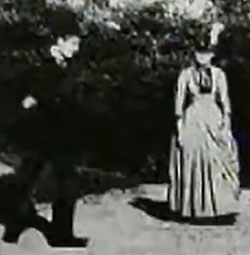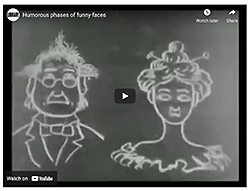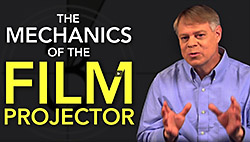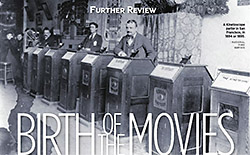Photography and Film
This chapter covers the invention and progression of photography, film, and color photography and film, from the 1820s to the Digital Age.
TOPICS
• Photo history: Camera obscura, Niépce, Daguerrotypes, Kodak film and cameras, SLRs
• Printing photos: Halftoning
• Moving pictures: Kinetograph, Kinetoscope, Cinématographe, Bell & Howell, projector technology
• Color film: Color theory, film for photos
• Film for movies: Additive, subtractive, Technicolor
• Impact: Photojournalism, Photography and society, Movies and society, The visual world
• Pinhole effect
• Camera obscura
• 1850s camera
• 1888 Kodak camera
• 1912 Vest Pocket Kodak
• 1925 Leica 35mm camera
• Single lens reflex
• Halftoning
• Kinetograph
• Kinetoscope
• Cinématographe
• 1912 Bell & Howell camera
• Projector technology
• Subtractive-additive colors
• Color gamuts
• Tripak color film
• Additive color movies
• Technicolor camera
• Subtractive film processing
• Photography timeline
• Niépce View from the Window at Le Gras
• Abraham Lincoln 1864
• Antietam Battlefield etching
• Mark Yamamoto Landscape
• Continuous projection result
• LePrince Roundhay Garden Scene
• Kinetograph movie still
• Maxwell and Sutton 1861 color photo
• Still from A Visit to the Seaside
• Natalie Kalmus portrait
• Ernest Brooks WWI Battle of Somme
Photography is the process of creating an image by capturing light. It relies on a method of focusing reflected light on to either a light-sensitive chemical surface or, in the digital age, to electronic sensors.
The oldest surviving photograph was taken in 1826 or 1827 by the French inventor Nicéphore Niépce. It is called ‘View from the Window at Le Gras’, depicting, as the title suggests, some buildings viewed through a window. The exposure took over eight hours.
Niépce had taken an earlier photo in 1822, but it was destroyed in an attempt to make prints from it. In 1829 he partnered with one of the best-known photo pioneers, Louis Daguerre, but the partnership did not last long as Niépce died in 1833. Daguerre moved the technology along, reducing exposure time from hours to minutes.
By the mid-1800s, photography was becoming practical enough to become commercialized. But it was not a medium of mass communication: Daguerre’s photos could only be reproduced by taking a second photo of them.
Two developments made photos more widely available. First was the invention of film, introduced by George Eastman in 1884. From film negatives multiple copies of prints could be easily made. Eastman founded the Eastman Kodak company, and introduced their first roll-film camera in 1888.
The second development was the invention of halftoning, also in the 1880s, which allowed photos to be printed on presses. Now newspapers and magazines could include photos on their pages.
Photography then led to movies. Thomas Edison unveiled his kinetoscope in 1891 by showing a short animated scene, introducing the new medium to the world.
The 20th century saw numerous advances such as color, and polaroids, and the perfection of movie-making. In time the possession of a camera became affordable and common, and most people had large collections of personal photos. It opened up the world for people, who could now see places and events far removed from their lives.
Photography
The Focal Encyclopedia of Photography: Digital Imaging, Theory and Applications, History, and Science, edited by Michael R. Peres, Routledge, 2007.
History and Evolution of Photography. Mark Osterman and Grant B. Romer, George Eastman House and International Museum of Photography and Film 2007.
The oldest known photo of a US President. Jason Kottke, kottke.org, Aug. 23, 2017.
Niépce and the Invention of Photography. Maison Nicéphore Niépce.
Camera Obscura
The Camera Obscura in History. obscurajournal.com.
Camera Lucida. Thomas B. Greenslade, Jr., Kenyon College.
Camera Obscura. Thomas B. Greenslade, Jr., Kenyon College.
Halftoning
Halftone. Dusan C. Stulik and Art Kaplan, The Getty Conservations Institute 2013.
Photojournalism: The Professionals’ Approach. Kenneth Kobre and Betsy Brill, Amsterdam: Focal 2004.
Portfolio 2: Pictorial Journalism. Library of Congress.
Newspapers and Half-tone Printing. sbmhist128.wordpress.com.
Cameras
Original Kodak Camera, Serial No. 540. National Museum of American History, Smithsonian Institution.
The Vest Pocket Kodak was the Soldier’s Camera. Colin Harding, Science+Media Museum, Mar. 13, 2014.
Single Lens Reflex Cameras. wileybookshop.com.
How the Brownie Camera Made Everyone a Photographer. Eric Schewe, daily.jstor.org, Dec. 26, 2018.
Cnopm (Sport) c. 1937. earlyphotography.co.uk.
Kine Exakta. wikipedia.org.
Asahi Pentax. wikipedia.org.
Early History of Single Lens Reflex (SLR) camera. Frank Mechelhoff, klassik-cameras.de, Nov. 26, 2009.
Kodak Brownie Camera. The Franklin Institute, Philadelphia PA.
Photographers on the Front Lines of the Great War. Craig Allen, The New York Times, Jun. 30, 2014.
Keppler’s Vault 38: Herbert & Huesgen Tourist Multiple. mikeeckman.com, May 16, 2019.
The Leica I: The Camera that Changed Photography. John Wade, shutterbug.com, July 13, 2015.
35mm Film Format – (135 Film). thedarkroom.com.
History of the 35mm: The Original Compact Camera. Colleen Welsch, theoldtimey.com.
Learn How the Brownie Camera Changed Photography Forever. Jennifer Rosenberg, thoughtco.com, Mar. 2, 2018.
SLR
Who Brought Us the SLR? Adam Oest, bhphotovideo.com, 2012.
A Single-Lens Reflex (SLR) Camera. wileybookshop.com.
Early History of Single Lens Reflex (SLR) camera. Frank Mechelhoff, klassik-cameras.de, 2005.
Asahi Pentax 'AP' (Tower 26). pentaxforums.com.
Color photography
A Short History of Color Photography. National Science and Media Museum, June 1, 2009.
Behold the Very First Color Photograph (1861): Taken by Scottish Physicist (and Poet!) James Clerk Maxwell. Josh Jones, openculture.com, Aug 22, 2016.
A Brief History of Color Photography, From Dream to Reality. Michael Archambault, petapixel.com, Oct. 11, 2015.
Film
Infoculture, the Smithsonian Book of Information Age Inventions. Steven Lubar, Houghton Mifflin 1993.
A Very Short History of Cinema. National Science and Media Museum, June 18, 2020.
Edison’s First Movie Projector: A Phonograph for Pictures. infostory.com, Oct. 17, 2013.
8.2 The History of Movies. University of Minnesota Libraries.
A Brief History of the Movie Camera. Amanda Green, Popular Mechanics, Dec. 14, 2012.
Louis Le Prince. BBC Education (web.archive.org).
Motion Picture Cameras – From Film to Digital Video! willevb.wordpress.com, Feb. 26, 2014.
The Race to Cinema theracetocinema.com.
Kinetograph and kinetoscope
Edison Kinetoscope. The Science Museum Group.
Thomas Edison patents the Kinetograph. history.com, May 28, 2021.
The First Motion Picture Shot in the United States. Jeremy M. Norman, historyofinformation.com.
Edison’s Kinetoscope. Museudelcinema (YouTube channel).
The Kinetoscope. American Society of Cinematopgraphers.
Cinematograph: Lumiere Brothers
Le Cinéma des Origines: Les Frères Lumière et leurs Opérateurs. Jacques Rittaud Hutinet, Edition du Champ Valon, France 1985.
The Ciné Goes to Town: French Cinema 1896–1914. Richard Abel, University of California Press 1994.
The Emergence of Cinema: The American Screen to 1907. Charles Musser, Charles Scribner’s Sons 1990.
The Rise of the Cinema in Great Britain. John Barnes, Bishopsgate Press 1983.
Lumière Cinématographe Camera, Printer, and Projector, 1895. National Museum of American History.
History of the Autochrome: The Dawn of Color Photography. The National Science and Media Museum, June 5, 2009.
Lumière Cinematographe Camera. Chapman University Digital Commons.
The Lumière Brothers, Pioneers of Cinema. Sarah Pruitt, history,com, Aug. 22, 2018.
Robert Paul and the Race to Invent Cinema. The National Science and Media Museum.
Bell & Howell
Bell & Howell Company: A 75-Year History. Jack Robinson, Bell & Howell 1982.
Bell & Howell Standard Cinemachinery Type 2709. chicagology.com, March 17, 2003.
Bell & Bell & Howell - The Studio Standard. firstcinemakers.com.
Film projector
How a Film Projector Works. engineerguy (YouTube channel).
Frame rate. en.wikipedia.org.
First movie projector demonstrated in United States. history.com, April 20, 2020.
8mm camera
1955-1969: Diversification in Development and Production. Canon Camera Museum.
Color film
Barbara Flueckiger’s Timeline of Historical Film Colors. UCLA Film & Television Archive, Aug. 3, 2018.
Timeline of Historical Film Colors. Barbara Flueckiger, filmcolors.org.
First-ever color movie found at Britain&s National Media Museum in Bradford. Christine Roberts, New York Daily News, Sept. 12, 2012.
A Short History of Color in Film and Television. Richard Wirth, provideocoalition.com, April 22, 2017.
Edward Raymond Turner. Luke McKernan, victorian-cinema.net.
Technicolor
Technicolor. Laurent Mannoni, Google Arts & Culture; The Cinémathèque Française and LIFE Photo Collection.
Technicolor 3 Strip. digital-intermediate.co.uk.
Technicolor 100. George Eastman Museum.
How Technicolor changed movies. Vox, Aug. 25, 2019.
How Technicolor Changed Storytelling. Adrienne LaFrance, The Atlantic, Feb. 2, 2015.
70mm movies
15 Essential Movies Shot On 70mm Film, From ‘2001: A Space Odyssey’ to ‘Dunkirk’. Zack Sharf, indiewire.com, July 12, 2017.
3D film
The History of 3D Movie Tech. Marc Nix, ign.com, April 18, 2016.
The First 3D Feature Film was Shown in 1922. Steve Palace, The Vintage News, March 20, 2019.
Best-selling movies
Box Office Champs. Charles Apple, The Spokesman-Review, June 11, 2020.
Most Watched Movies Of All Time. IMDb, Nov. 14, 2015.
Digital movies
The Triumph of Digital Will Be the Death of Many Movies. Helen Alexander and Rhys Blakely, The New Republic, Sept. 12, 2014.
Cinemas may soon replace the 125-year-old projector screen with gigantic TVs. Ashley Rodriguez, Quartz, July 12, 2017.
NOTE: Weblinks were current and active at the time of the last update to the site, but may have since become unavailable or outdated. If you encounter a dead link, please notify me at phil.loubere@mtsu.edu. Thanks.
Last update: May 2021
Content related to this chapter’s topics will be periodically posted here.
Eastman Kodak

How Kodak made photography accessible to the public. Vox, Sept. 24, 2024.
Eastman Kodak’s 1888 introduction of roll film made it possible for anyone to take photos.
Louis LePrince

He Created the First Known Movie. Then He Vanished. Leah Greenblatt, New York Times, April 16, 2022.
In his new book, “The Man Who Invented Motion Pictures,” Paul Fischer investigates the life — and mysterious disappearance — of Louis Le Prince.
First animated cartoon

Watch the world's first animated cartoon from 1906. Swapnil Dhruv Bose, faroutmagazine.co.uk, April 6, 2021.
British-American filmmaker James Stuart Blackton made this animation in 1906 by drawing charicatures with chalk on a blackboard.
How a projector works

How a film projector works. This YouTube video shows the parts and mechanics of how a projector advances each frame and illuminates it.
Birth of the Movies

Birth of the Movies—The Spokesman-Review. This Further Review page by Charles Apple gives a brief history of the early days of movies. Apple's pages run in The (Spokane, WA) Spokesman-Review newspaper as well as numerous other papers across the US.
Last update: September 2024



